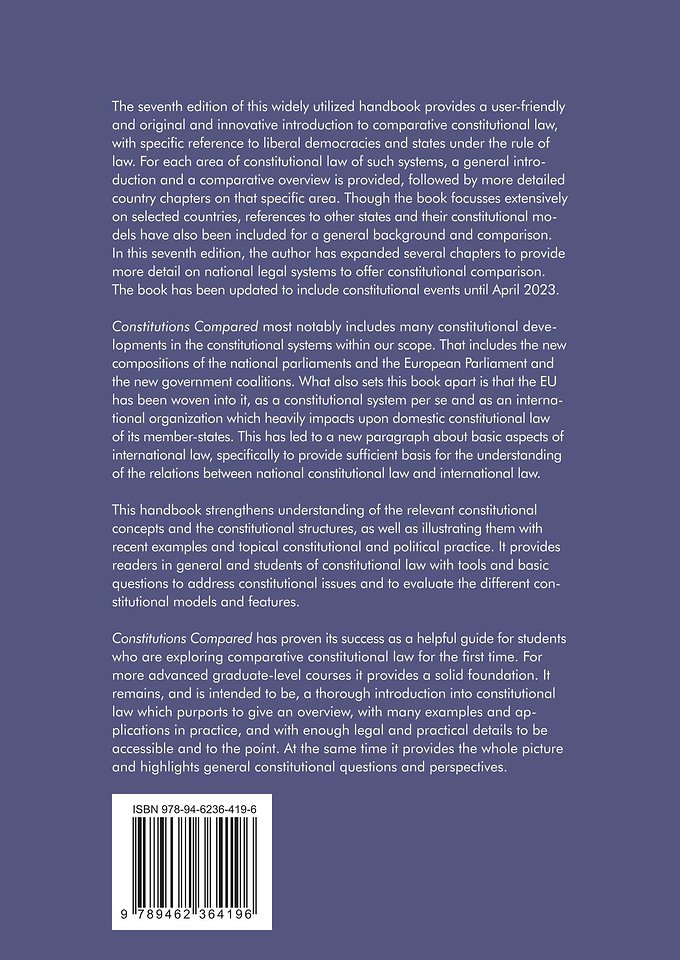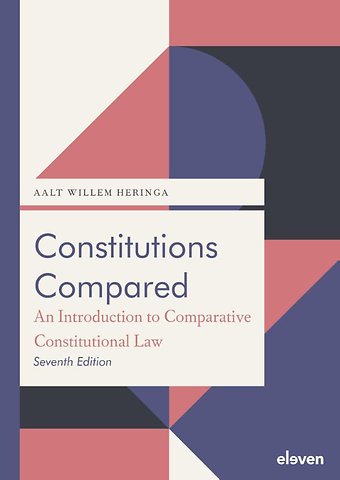



Aalt Willem Heringa (1955) graduated from the Rijksuniversiteit Leiden in 1978, where he worked until 1987 as an assistant professor.
Meer over Aalt Willem HeringaConstitutions Compared
An Introduction to Comparative Constitutional Law
Samenvatting
The seventh edition of this widely utilized handbook provides a user-friendly and original and innovative introduction to comparative constitutional law, with specific reference to liberal democracies and states under the rule of law. For each area of constitutional law of such systems, a general introduction and a comparative overview is provided, followed by more detailed country chapters on that specific area. Though the book focusses extensively on selected countries, references to other states and their constitutional models have also been included for a general background and comparison.
In this seventh edition, the author has expanded several chapters to provide more detail on national legal systems to offer constitutional comparison. The book has been updated to include constitutional events until April 2023. Constitutions Compared most notably includes many constitutional developments in the constitutional systems within our scope. That includes the new compositions of the national parliaments and the European Parliament and the new government coalitions.
What also sets this book apart is that the EU has been woven into it, as a constitutional system per se and as an international organization which heavily impacts upon domestic constitutional law of its member-states. This has led to a new paragraph about basic aspects of international law, specifically to provide sufficient basis for the understanding of the relations between national constitutional law and international law.
This handbook strengthens understanding of the relevant constitutional concepts and the constitutional structures, as well as illustrating them with recent examples and topical constitutional and political practice. It provides readers in general and students of constitutional law with tools and basic questions to address constitutional issues and to evaluate the different constitutional models and features.
Constitutions Compared has proven its success as a helpful guide for students who are exploring comparative constitutional law for the first time. For more advanced graduate-level courses it provides a solid foundation. It remains, and is intended to be, a thorough introduction into constitutional law which purports to give an overview, with many examples and applications in practice, and with enough legal and practical details to be accessible and to the point. At the same time it provides the whole picture and highlights general constitutional questions and perspectives.
Trefwoorden
Specificaties
Inhoudsopgave
U kunt van deze inhoudsopgave een PDF downloaden
1. Introduction 19
2. The Meaning of a Constitution 24
3. The Flexibility of Constitutions 30
4. Terminology 35
4.1. State 35
4.2. Country 37
4.3. Nation 37
4.4. Government 38
4.5. Republic and Monarchy 38
4.6. Democracy 42
5. Political Parties 44
6. International Law Fundamentals 45
7. Guide to the Use of This Book 51
8. Concluding Comments 52
9. Further Reading 52
2 Constitutions Compared: Origins and Main Features 55
1. Overview 55
1.1. The Notion of Sovereignty 56
1.1.1. Popular versus Royal Sovereignty 57
1.1.2. Popular versus National Sovereignty 57
1.1.3. Popular versus State Sovereignty 58
1.1.4. Parliamentary Sovereignty 59
1.1.5. The Absence of Sovereignty 62
1.1.6. Sovereignty and European Integration 62
1.2. Parliamentary and Presidential Systems 65
1.3. Separation of Powers and Checks and Balances 68
1.4. The Role of Judges 72
1.5. State Structure: Unitarism and Federalism 73
1.6. Rule of Law / Rechtsstaat 74
1.7. Summary 75
1.8. Further Reading 76
2. The United States 77
2.1. Civil War and Reconstruction 77
2.2. The US Constitution 78
3. Germany 81
3.1. National Unification 81
3.2. Division and Reunification 83
3.3. The Basic Law 84
4. The United Kingdom 87
4.1. Monarchy and Parliament 87
4.2. The UK Constitution 89
4.3. The UK and Europe 94
5. France 95
5.1. A Sequence of Constitutions 95
5.2. The Constitution of the Fifth Republic 97
6. The Netherlands 99
6.1. Dutch Independence and the French Period 100
6.2. The Kingdom of the United Netherlands 101
6.3. The Dutch Constitution 102
6.4. The Charter for the Kingdom 105
7. The European Union 106
3 Federalism, Unitarism and Decentralization 111
1. Overview 111
1.1. Degrees of Federalism and Devolution 113
1.2. Types of Federalism and Devolution 116
1.3. Federalism and the European Union 117
1.4. Summary 119
1.5. Further Reading 121
2. The United States 121
2.1. US Federalism: The Senate 122
2.2. Federalism and the House of Representatives 122
2.3. Vertical Separation of Powers 123
2.4. Federalism at Presidential Elections 127
2.5. Federalism and the Executive and Judicial System 127
3. Germany 128
3.1. German Federalism: The Bundesrat 129
3.2. Federalism and the Bundestag 130
3.3. The Competences of the Federal Lawmaker 132
3.4. Federalism and the Election of the Federal President 133
3.5. Federalism and the Executive and Judicial System 134
4. The United Kingdom 134
5. France 138
6. The Netherlands 139
6.1. Decentralization in the Netherlands 140
6.2. The Overarching Kingdom 142
7. The European Union 143
7.1. EU’s Competences 143
7.2. EU’s Institutions 144
7.3. Execution 145
7.4. Supremacy 146
7.5. Democracy Deficit? Accountability, Legitimacy and National Parliaments 147
4 Parliaments and Lawmaking 151
1. Overview 151
1.1. Principles of Elections 156
1.2. Election Systems 159
1.3. Bicameralism 163
1.4. The Legislative Process 165
1.5. Referenda 168
1.6. The Government and the Head of State 170
1.7. Parliamentary Privilege 173
1.8. Political Parties 173
1.9. Summary 174
1.10. Further Reading 175
2. The United States 175
2.1. The House of Representatives 176
2.2. The Senate 179
2.3. Federal Lawmaking 181
2.4. The President 184
2.5. Political Parties 185
3. Germany 186
3.1. The Bundestag 186
3.2. Election System 188
3.2.1. Seat Distribution 188
3.2.2. The Threshold 192
3.2.3. Unconstitutionality 193
3.3. The Bundesrat 196
3.4. Federal Lawmaking 198
3.4.1. The Legislative Process 199
3.4.2. The Bundesrat 200
3.4.3. The President 203
3.5. Political Parties 204
4. The United Kingdom 205
4.1. The Commons 205
4.2. The Lords 207
4.3. The Legislative Process 210
4.3.1. Royal Assent 213
4.3.2. The Lords 213
4.4. Political Parties 215
5. France 216
5.1. The National Assembly 216
5.2. The Senate 219
5.3. The Legislative Process 221
5.3.1. The Senate 224
5.3.2. Organic Statutes 224
5.3.3. The President 225
5.3.4. The Constitutional Council 226
5.4. Political Parties 229
6. The Netherlands 229
6.1. The Second Chamber 230
6.2. The First Chamber 233
6.3. The Legislative Process 235
6.3.1. Statutes for the Netherlands in Europe 236
6.3.2. The King/Queen 238
6.3.3. Statutes for the Overall Kingdom 238
6.4. Political Parties 239
7. The European Union 239
7.1. Commission 240
7.2. Council 241
7.3. European Parliament 242
7.4. EU Lawmaking 242
7.5. Political Parties 242
7.6. Role of Member States and Their Parliaments in EU Lawmaking 243
5 Governments, Their Parliaments and Their Heads of State 245
1. Overview 245
1.1. Heads of State and Government 245
1.2. The Rank of the Prime Minister 249
1.3. Parliamentary Investiture 251
1.4. Ministerial Accountability 253
1.5. Parliamentary Scrutiny 259
1.6. National Parliaments and the European Union 260
1.7. The Immunity of the Head of State 262
1.8. Dissolution of Parliament 264
1.9. Summary 267
1.10. Further Reading 268
2. The United States 268
2.1. The President and Vice-President 269
2.2. The President and Congress 273
2.3. Congressional Scrutiny 275
3. Germany 275
3.1. The Federal President 276
3.2. The Chancellor and His/Her Government 279
3.3. Ministerial Accountability 280
3.4. Parliamentary Scrutiny 282
3.5. Confidence Question 283
4. The United Kingdom 285
4.1. The King/Queen 285
4.2. The Prime Minister and His/Her Cabinet 287
4.3. Parliamentary Scrutiny 288
4.4. Ministerial Accountability 289
5. France 293
5.1. The President 293
5.2. The Prime Minister and His/Her Government 295
5.3. Ministerial Accountability 297
5.4. Parliamentary Scrutiny 299
6. The Netherlands 299
6.1. The King/Queen 300
6.2. The Prime Minister and His/Her Cabinet 302
6.3. Ministerial Accountability 303
6.4. Motions of No Confidence 306
6.5. Parliamentary Scrutiny 307
6.6. The Government of the Kingdom 308
7. The European Union 308
7.1. Multiple Presidents 309
7.2. Motions of No Confidence 311
7.3. Accountabilities and Dual Legitimacy 311
7.4. Parliamentary Scrutiny 312
6 Judicial Review and Court Systems 315
1. Overview 315
1.1. Constitutional Review of Legislation 316
1.2. The Procedural Setting of Constitutional Review 319
1.3. Review of Treaty Law Compliance 323
1.4. European Union Law 327
1.5. Role of Courts and Interpretation 330
1.6. Summary 332
1.7. Further Reading 333
2. The United States 333
2.1. The Court System 333
2.2. Constitutional Review 337
2.3. International Treaties 340
3. Germany 342
3.1. The Court System 342
3.2. Constitutional Review 343
3.3. International Treaties and the ECHR 347
3.4. European Union Law 348
4. The United Kingdom 350
4.1. The Court System 350
4.2. Constitutional Review 350
4.3. International Treaties and the ECHR 352
4.4. European Union Law 355
5. France 356
5.1. The Court System 356
5.2. Constitutional Review 358
5.3. International Treaties and the ECHR 360
5.4. European Union Law 360
6. The Netherlands 361
6.1. The Court System 361
6.2. Constitutional Review 362
6.3. International Treaties and the ECHR 363
6.4. European Union Law 365
7. The European Union 365
7.1. EU Courts 366
7.2. National Courts and EU 366
7.3. The EU Charter of Fundamental Rights 367
7 Human Rights 369
1. Overview 369
2. The United States 369
3. Germany 373
4. The United Kingdom 376
5. France 378
6. The Netherlands 380
7. The European Union 381
8. European Human Rights 384
9. The ECHR, the European Union and the National Constitutions 389
8 Concluding Comparative Comments 393
1. Constitutions as Balancing Acts 395
2. Multiple European Legal Orders and Multi-Level Governance 398
Annex 1 List of Tables, Charts and Graphs 403
Annex 2 Useful Links 405
Annex 3 Exercises and Self Tests 407
Annex 4 Glossary 415
Annex 5 Overview of Constitutions Compared 423
Index 427
Anderen die dit boek kochten, kochten ook
Net verschenen
Rubrieken
- aanbestedingsrecht
- aansprakelijkheids- en verzekeringsrecht
- accountancy
- algemeen juridisch
- arbeidsrecht
- bank- en effectenrecht
- bestuursrecht
- bouwrecht
- burgerlijk recht en procesrecht
- europees-internationaal recht
- fiscaal recht
- gezondheidsrecht
- insolventierecht
- intellectuele eigendom en ict-recht
- management
- mens en maatschappij
- milieu- en omgevingsrecht
- notarieel recht
- ondernemingsrecht
- pensioenrecht
- personen- en familierecht
- sociale zekerheidsrecht
- staatsrecht
- strafrecht en criminologie
- vastgoed- en huurrecht
- vreemdelingenrecht





